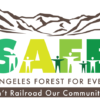Reprinted by permission from California Rail News
By David Schonbrunn
The Governor’s startlingly candid admission that “Right now, there simply isn’t a path to get from Sacramento to San Diego, let alone from San Francisco to LA” has triggered what could become a major reassessment of the State’s commitment to this project. Governor Newsom’s candor was a total break from eight years of uncompromising support by Jerry Brown for a project that still has no realistic long-term funding.
The release of the California High-Speed Rail Authority’s (CHSRA) 2019 Project Update Report. and the Trump Administration’s cancellation of a $929 million grant to the project, when added to the Governor’s statement, combine to create a highly dynamic situation. While the State has sued the federal government to recoup the funds, no one knows where any of this will end up.
CHSRA’s new plan calls for HSR service between Bakersfield and Merced. This $20 billion plan would cost $15 billion more than the $5 billion that has already been spent. Unlike any normal rail project, that $5 billion has not delivered any benefits to the public, especially not improved passenger service. Legislative hearings so far suggest a far higher level of skepticism than previous years that this project is worth doing.
TRAC’s Observations about the Update
The plan rests on the fundamental premise that this service will serve as “a building block” for a statewide HSR system. In fact, CHSRA has never had a realistic plan to fund the building of a statewide HSR system. As a result, there simply won’t be a statewide system, despite the intense flurry of consultant work to put together plans for one. That means the proposed HSR system will never be more than a standalone Bakersfield-to-Merced line.
While transportation projects are judged on their cost/benefit ratio, the new plan completely flunks that test. No one outside of California would seriously propose to commit $20 billion to a standalone project like this. That’s roughly the cost of London’s new Crossrail subway system, which will carry vastly more ridership. That extraordinary amount of money for a project with such modest benefits is ridiculous. For less than 5% of that amount, Central Valley rail service could be made much faster. (See also, past issues of California Rail News.)
It’s unclear whether the primary purpose of the Project Update is to keep the consultant gravy train in motion, or merely to be able to claim that the project is going forward, to avoid having to give back billions of dollars to the Trump Administration. What is clear is that this is not a project being proposed on its merits.
The private sector has wanted to invest in passenger rail in California, but has been blocked by politicians promoting CHSRA’s project. CHSRA was once offered a funded plan, but rejected it. The French National Railways proposed to build an HSR line from Los Angeles to San Francisco on a different route than CHSRA had approved, with funding from an investment bank. CHSRA rejected the offer and instead launched into construction with the State taking on 100% of the risk. By keeping the French offer secret, CHSRA showed that it had priorities other than getting HSR built and that it did not want those priorities known by the public.
TRAC has long been a supporter of high-speed rail (HSR) as the low-pollution way to connect the regions of our large state. We have objected to the design of this HSR project from its inception, however, because it is so distorted by political compromises. The complete lack of interest from the private sector in investing in this project, while private sector entities thought an HSR system on another route would be profitable, is proof that its design is deeply flawed. Without investment from the private sector, there is no way a statewide project can be built. Federal and State funding can never be enough.
The Project Update acknowledges that Bakersfield-Merced HSR service will not earn its operating costs. That violates an explicit provision of the 2008 HSR Bond measure, which promised voters that no bond funds could be used to build HSR tracks whose operations would require subsidies.
Brian Kelly, CEO of CHSRA, stated that, “Once [the project’s] done,” he said, “it will unlock financing to tunnel beneath Pacheco Pass to reach San Jose’s Diridon Station…” Kelly’s assertion that a money-losing service will attract the $14+ billion in private investment needed to connect the Central Valley to San Jose defies all logic.
There is no assurance that the private sector would have any interest in investing in California HSR, if this Central Valley project were ever completed. Before spending $15 billion on this project, it would be prudent to invite the private sector to indicate what it would be willing to invest in.
CHSRA has been actively promoting the concept that HSR is part of the solution to Northern California’s housing crisis. The 2018 CHSRA Business Plan states that a Fresno-to-San Jose round trip ticket would cost $132. (HSR’s primary patrons have always been expected to be business people.) Even with a monthly discount, these HSR tickets would be far too expensive for daily commuting. Any benefit of lower housing costs would be wiped out by much higher commuting costs. TRAC believes HSR’s housing benefits to be non-existent.
Now that the HSR project has been downsized to only the Central Valley, there is no legitimacy to the claim that the project will produce meaningful GHG reductions. As a result, CHSRA should no longer be eligible for Cap and Trade money. Without that money, CHSRA would have to concede it cannot build this project.
The ridership projections are based on 19 HSR trains per day, per direction. However, limited infrastructure means that only 9 of those trains could connect to trains to the Bay Area. That makes the proposed project’s ridership projections impossible to achieve within its estimated cost. Currently, the Altamont Commuter Express (ACE) can only offer a maximum of 4 round-trips a day. The San Joaquins operate 5 trains a day to the Bay Area via a circuitous route that doesn’t go to Silicon Valley. Connecting every HSR train to a train to the Bay Area or Sacramento would require the expenditure of many more billions, which have not been included in the HSR cost estimates.
Ridership for the Valley HSR line is based on Amtrak-level fares. Every other HSR system in the world charges premium fares. The obvious implication of this assumption is that the ridership was tested using the fares proposed in the CHSRA 2018 Business Plan. Those ridership projections must have been so dismal that they were unusable. Using Amtrak fares for Valley HSR is a tacit admission that traveling at high speeds is not valued by the Central Valley travel market. If the Valley isn’t willing to pay for HSR, why should the State?
What It All Means
The new plan is mired in the sunk cost fallacy: “Because $5 billion has already been spent, we need to finish the project.” It is foolish to spend a lot more money to make an initial decision to spend look reasonable, if the project itself isn’t worth that money. It would be far better to cut California’s losses now, when it is obvious there is no upside. Let’s not throw good money after bad.
This is an exciting time for rail advocates to be putting forward their ideas for alternatives to CHSRA’s plans. There is a possibility of change in the air that was not present during the Brown Administration. TRAC has extensive plans for improving California Rail, which were presented to Governor Newsom’s staff. We continue to believe that cost-effective plans, tied to investment from the private sector, are the most feasible way to improve California’s long-distance mobility. Our website, calrailnews.org, will soon be showcasing our plans.
Dan Walters best summarized CHSRA’s situation: “The bullet train utterly lacks a rational purpose, has been ill-managed from the onset and is a black financial hole. If the Trumpies strangle it, they would be doing California a big favor.” TRAC would add: “There’s lots to do to improve California rail. Let’s not let this bad project sour us on improving rail transportation.”





